NEW ORLEANS
August 28, 2009
STRANGER: Jerry Gandolfo
LOCATION: The Court of Two Sisters, 613 Royal Street, New Orleans
THEME: Curious about a curator
Sometimes the lingering effects of Hurricane Katrina show themselves in New Orleans in small ways you might not otherwise notice.
At the famous Court Of Two Sisters restaurant, before the 2005 hurricane you might struggle to get a prime time Saturday night reservation. Even if you got one, you’d have a wait before being seated. When Jerry Gandolfo and I went to dinner — with a reservation — early evening one Saturday night in August 2009, we were shown immediately to our seats in the restaurant’s lush courtyard, with just a handful of other diners in the place.
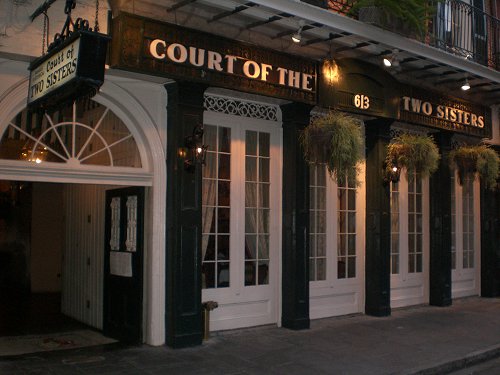
Still, Jerry said that even though the restaurant remains much quieter than the pre-hurricane days, he can tell a positive improvement compared to just one year ago, because the place was noticeably busier this year. That fits in with his view that the city is probably around the halfway point of its long path back to full recovery.
Jerry, 57, had to move out of his hurricane-damaged house in the wake of Katrina, but he’s still working on restoring his home and more broadly is eager to help the city rebuild however he can. One way to aid that recovery is through boosting tourism levels back up, because the dollars that visitors like myself and others from across the world spend when we’re on holiday in the Big Easy were — and will continue to be — a huge industry, he said.
The imaginary generic tourist would have a checklist of New Orleans that would likely include the words drinks, food, swamps, and voodoo. It’s the latter interest that Jerry caters to in his position as curator of the New Orleans Historic Voodoo Museum.
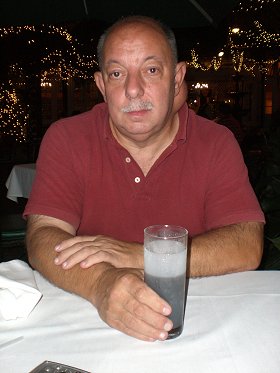
Jerry was born and raised in New Orleans and has lived there most of his life except for a brief stint serving in the army. As we got acquainted in the lush, quiet restaurant courtyard on a warm but pleasant night — something Jerry said was an abnormality for that time of year, when it’s usually stiflingly hot and humid — he led me through the life path that brought him to his current job.
He went to high school in the city and then in the 1960s went to the University of New Orleans for a degree in political science, something he said was inspired by the idealism of the era stemming from Jack and Robert Kennedy and Martin Luther King, Jr. “I always loved politics, but it was a useless degree,” he said with a grin. So at the same time he enrolled at Tulane University for the Reserve Officers’ Training Corps army training program, and sometimes handling two courses at once meant “I’d get up some mornings and forget which university I was supposed to go to.”
After completing his degrees, Jerry was prepared to enlist in the Army because back then the draft was still in place. But the Vietnam war was ending and the government put in place a reduction in forces, meaning that he never saw active duty until the first Gulf War. Even then, he didn’t leave the country, serving instead at a command in Falls Church, Virginia. And that is the extent to which Jerry has lived outside of his clearly beloved New Orleans.
It was while Jerry was involved with the Army that his brother founded the New Orleans Historic Voodoo Museum in 1972 and ran it for decades. The business was taken over by Jerry’s nephew earlier this decade when his brother died. After about three years of the nephew running the place, workers started to come to Jerry and tell him they weren’t getting paid, and asked if he could help. He investigated, spoke with the nephew and found out he was more than happy to sell his interest. That’s how Jerry took over and became the owner and operator of the museum, just a few months before Hurricane Katrina hit.
“I’m trying to breathe life back into the Voodoo museum”
Before the hurricane, he lived in an area named Mid-City, but the place was flooded with nine feet of water and ever since he’s been staying with his sister in the suburbs in an area named Metairie. While he gets on well with his sibling, “I’ve been there long enough that I’m ready to go back and let her have her own place back,” he said.
The museum didn’t suffer a similar fate because the French Quarter largely escaped the brunt of the devastation. The real damage has been in the major drop in tourism levels, and ever since the hurricane “I’ve been trying to breathe life back” into the museum, Jerry said.
He’s keen to stress that yes, the city is safe to visit, something I can attest to having been for work and personal visits several times over the last few years. But it’s a message that’s slow to sink in. “I still get e-mails from people wanting to know when it’ll be safe to come back.” For example, Jerry told the story of a screenwriter from Los Angeles who came to research voodoo for a project, and her mother sent her a package containing bottled water and canned food. Jerry said it remains a big challenge trying to overcome people’s fears of returning to the city.
Those fears are definitely unfounded, and the evening we spent at the restaurant was a pleasant, relaxing couple of hours. And the hurricane has not damaged the city’s ability to provide excellent cuisine. This is roughly when my starter arrived, a plate of fried green tomatoes with jumbo lump crabmeat and a sauce ravigote.
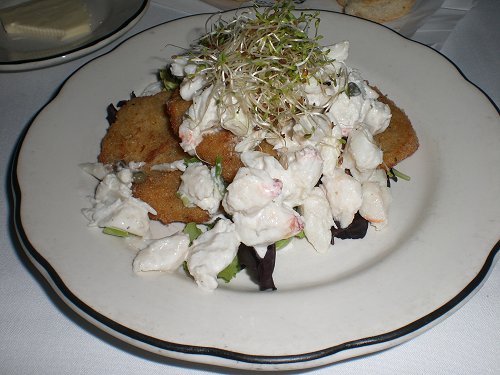
They sure serve large portions in the Crescent City. For $12 I got enough food to qualify as a main course, but I’m a glutton so I was able to eat the starter and still have room for the rest of the meal. The tomatoes were fried in a tasty breadcrumb coating, and the crabmeat was soft and delicious, topped off with a crisp and refreshing sauce. The only downside was that the tomatoes were a little on the lukewarm side, but with an appetizer this good that’s a minor qualm.
It was a good promise of the main course to come, and made me wonder why the restaurant wasn’t busier if they were serving up such tasty dishes. Of course, it’s because of the drop in tourism since the hurricane. Jerry is confident that tourists will return, simply because New Orleans offers visitors — particularly those from overseas — so much that they can’t get at home. It’s pointless trying to sell the city’s history to foreigners because it’s only a few hundred years old whereas foreign cities have buildings that are thousands of years old, Jerry said.
“They come here because they want to see jazz, voodoo, alligators, they want the cultural experience,” he added. Jerry’s in a good position to play a key role serving up what the tourists want by giving them what he described as an objective look at the religion’s history.
“My interest in voodoo has always been more academic and historical. To run a museum you need to have some distance and objectivity.” People that practice voodoo, or say they practice it, are a “dime a dozen” and the museum is just that, it’s not a temple or gimmick, he said.
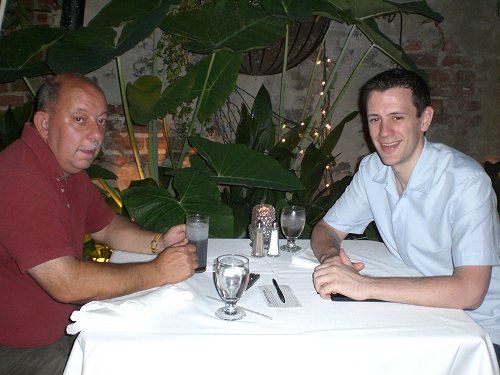
On walking tours of the French Quarter and at the museum, Jerry likes to divide voodoo into four broad categories. First is voodoo as a religion, with followers who believe that the supernatural is responsible for events in their lives. Second is voodoo as superstition, identical to the first category except people deal with fetish objects — like a rabbit’s foot — and don’t associate them with spirits that have religious overtones. Third is folklore, the oral tradition of voodoo handed down generations, and in New Orleans that is dominated by tales of the voodoo practitioner Marie Laveau. Fourth is what Jerry calls fakelore, or the misuse of folklore for personal gain by con-men (and women) out to make a quick dollar from a tourist.
Jerry details all four at his museum, which features an altar room in the back, a hallway detailing this history of voodoo, and a small room dealing with the history of zombies — which apparently are a big part of the religion that originates from the African country of Benin.
He had plenty of voodoo stories to share over dinner, many of them too lengthy to reprint here, though I’ll share one at the end of this article. Besides, you should go visit the museum and take one of Jerry’s tours to find out for yourself. He’s a man with a deep knowledge of the subject and he has a knack for explaining things in perfectly understandable terms, but influenced ever so slightly with the laid back and joyous attitude that Jerry was born with because he’s Creole.
The term refers to people descended from settlers in French Louisiana before it became part of the United States, and Jerry said Creoles and Americans were in conflict for the longest time because, he said, “The Creole is dedicated to the love of life and experiencing it, whereas the Americans are dedicated to making money.” Jerry said that Creole is a state of mind that’s “very much about not being practical. It’s about giving in to lifelong pleasures.”
Giving in to lifelong pleasures helps me transition somewhat easily to discussing our indulgence in the large main courses, which arrived piping hot.
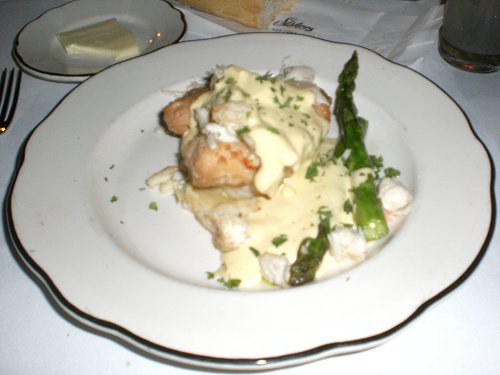
I chose the chicken Oscar, boneless chicken breast served atop new potato mash and steamed asparagus and topped with lump crabmeat (more crabmeat!) and tasso hollandaise. It was outstanding, the flavors all coming together perfectly. The chicken was tender and the combination with the crabmeat and sauce was fantastic, though I do question the $28 price tag. Great food, but could have done with being cheaper.

Jerry ordered the grilled pork tenderloin medallions, which came with peas and crispy bacon risotto and a Marchand de Vin sauce. He gave high marks to the dish, which cost $26. I can’t say whether it was worth that, because I didn’t try any of his food.
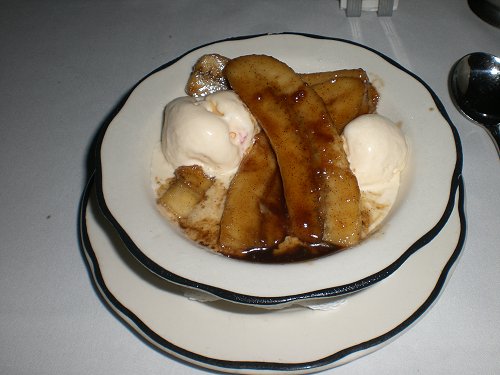
My dessert was as delicious as the main course. I opted for the Bananas Foster, a great dish special to New Orleans that I’ve struggled to find recreated well anywhere but that city. Butter, sugar, cinnamon, and bananas cooked and then ignited with dark rum and banana liqueur and served over vanilla ice cream. It was fantastic and well worth the $8.
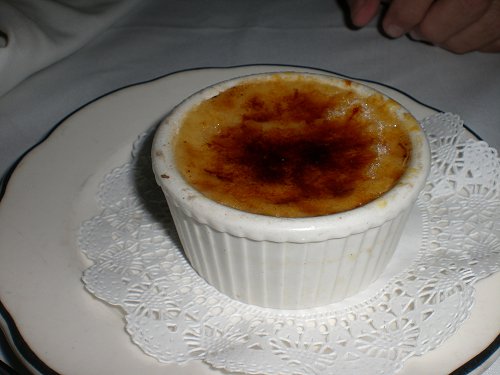
Jerry ordered an $8 crème brûlèe to which he gave high marks. I was very pleased with the consistent high quality at the restaurant, and it was a great beginning to my latest stay in the city. It’s a place I’ve grown to love very quickly, and Jerry could understand why.
“New Orleans is unique enough that if you’re born here it’s very hard to live elsewhere. It’s hard to live in a city that doesn’t have Mardi Gras,” the hectic annual street parade of notoriety. Jerry said he likes the “bohemian, joie de vivre lifestyle” which is also one reason why he’s confident the city will recover. “America needs us, we’re the place that people come to. They can come here, wear a mask, and do whatever they want, then go home and talk about how crazy the people down here are but not how crazy they got. We’re a little pressure valve for America.”
I heartily agree, not that this innocent, straight-laced British man would ever do anything crazy. Ahem.
“It’s not my job to advocate”
Moving on swiftly, I promised to share one of Jerry’s stories and I’m a man of my word so here goes. It’s about a famous New Orleans ragtime musician named Jelly Roll Morton.
Born in 1890, his mother died when he was eight years old and he went to live with his grandmother. But when he decided he wanted to be a musician, his grandmother considered this inappropriate and kicked him out the house. So he went to live with his godmother Eulalie Hécaud, who just happened to be a voodoo queen — and this is where the story kicks in.
In voodoo there are two spirits, a great angel and small angel. In New Orleans voodoo, once someone dies a practicing queen can exorcize the small angel and keep it in a voodoo altar. “It’s like hiring an attorney on retainer,” Jerry explained. But there’s a price. “She can guarantee fame and fortune, but when she dies, you die, so you always want to get a young voodoo queen.”
Well, Eulalie told aspiring musician Jelly Roll to go and wait for three days at a bordello in the Storyville part of town. On the third day, the bordello’s piano player called in sick and they asked whether anyone could take his place. Jelly Roll did so and played his original compositions, including a tune titled Wolverine Blues, and that’s considered the first place jazz was ever played, according to Jerry’s tale.
Then in 1917 the bordello closed and Jelly Roll was looking for work. His godmother told him to wait at a specific restaurant for three days, and sure enough on the third day a man came into the venue and after meeting Jelly Roll asked to put his records on cylinder — making him famous and guaranteeing he’d be rich through the 1920s.
But then came the era of the big bands and swing, and jazz fell out of favor. Eulalie told her godson to wait in his apartment for three days. On the third day he came out, and met a man who signed him to a 10-year record contract.
Pretty nice life right? Here comes the catch. In the 1940s while jazz was making a small comeback, Jelly Roll heard that his godmother had died. Four days later, at the age of 51, Jelly Roll died of no apparent cause — but voodoo practitioners will tell you that’s the price of taking on a voodoo queen to exorcize a small angel.
As the check arrived, I asked Jerry whether he believed the Jelly Roll Morton story and a host of other voodoo tales he’d shared over dinner.
“You can plead it either way. People who have faith need no proof, people who need proof have no faith. It’s not my job to advocate,” he said, with the slightest hint of a grin.
I loved the voodoo museum when I was in nola 8-9 years ago! a place so different from your everyday “local museums”! (when you go back, you gotta try “willie mae’s” chicken. I think it was in the ninth ward (not sure!)but has been talked about on “food channel” and many other places). thanks for an interesting interview/review.
1059xq